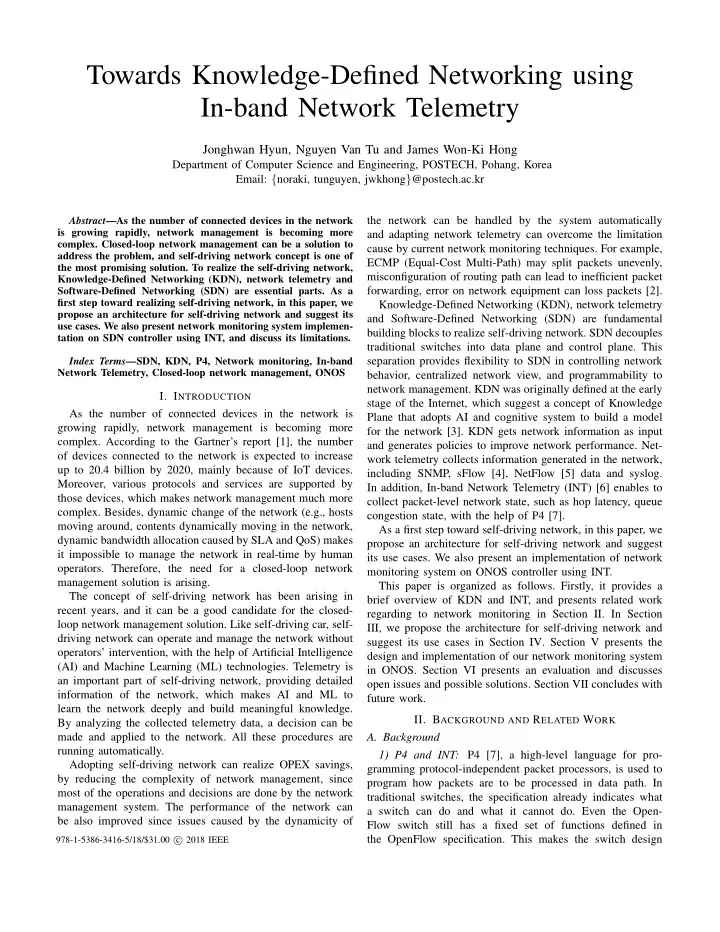

Towards Knowledge-Defined Networking using In-band Network Telemetry Jonghwan Hyun, Nguyen Van Tu and James Won-Ki Hong Department of Computer Science and Engineering, POSTECH, Pohang, Korea Email: { noraki, tunguyen, jwkhong } @postech.ac.kr the network can be handled by the system automatically Abstract —As the number of connected devices in the network is growing rapidly, network management is becoming more and adapting network telemetry can overcome the limitation complex. Closed-loop network management can be a solution to cause by current network monitoring techniques. For example, address the problem, and self-driving network concept is one of ECMP (Equal-Cost Multi-Path) may split packets unevenly, the most promising solution. To realize the self-driving network, misconfiguration of routing path can lead to inefficient packet Knowledge-Defined Networking (KDN), network telemetry and forwarding, error on network equipment can loss packets [2]. Software-Defined Networking (SDN) are essential parts. As a first step toward realizing self-driving network, in this paper, we Knowledge-Defined Networking (KDN), network telemetry propose an architecture for self-driving network and suggest its and Software-Defined Networking (SDN) are fundamental use cases. We also present network monitoring system implemen- building blocks to realize self-driving network. SDN decouples tation on SDN controller using INT, and discuss its limitations. traditional switches into data plane and control plane. This separation provides flexibility to SDN in controlling network Index Terms —SDN, KDN, P4, Network monitoring, In-band Network Telemetry, Closed-loop network management, ONOS behavior, centralized network view, and programmability to network management. KDN was originally defined at the early I. I NTRODUCTION stage of the Internet, which suggest a concept of Knowledge As the number of connected devices in the network is Plane that adopts AI and cognitive system to build a model growing rapidly, network management is becoming more for the network [3]. KDN gets network information as input complex. According to the Gartner’s report [1], the number and generates policies to improve network performance. Net- of devices connected to the network is expected to increase work telemetry collects information generated in the network, up to 20.4 billion by 2020, mainly because of IoT devices. including SNMP, sFlow [4], NetFlow [5] data and syslog. Moreover, various protocols and services are supported by In addition, In-band Network Telemetry (INT) [6] enables to those devices, which makes network management much more collect packet-level network state, such as hop latency, queue complex. Besides, dynamic change of the network (e.g., hosts congestion state, with the help of P4 [7]. moving around, contents dynamically moving in the network, As a first step toward self-driving network, in this paper, we dynamic bandwidth allocation caused by SLA and QoS) makes propose an architecture for self-driving network and suggest it impossible to manage the network in real-time by human its use cases. We also present an implementation of network operators. Therefore, the need for a closed-loop network monitoring system on ONOS controller using INT. management solution is arising. This paper is organized as follows. Firstly, it provides a The concept of self-driving network has been arising in brief overview of KDN and INT, and presents related work recent years, and it can be a good candidate for the closed- regarding to network monitoring in Section II. In Section loop network management solution. Like self-driving car, self- III, we propose the architecture for self-driving network and driving network can operate and manage the network without suggest its use cases in Section IV. Section V presents the operators’ intervention, with the help of Artificial Intelligence design and implementation of our network monitoring system (AI) and Machine Learning (ML) technologies. Telemetry is in ONOS. Section VI presents an evaluation and discusses an important part of self-driving network, providing detailed open issues and possible solutions. Section VII concludes with information of the network, which makes AI and ML to future work. learn the network deeply and build meaningful knowledge. II. B ACKGROUND AND R ELATED W ORK By analyzing the collected telemetry data, a decision can be made and applied to the network. All these procedures are A. Background running automatically. 1) P4 and INT: P4 [7], a high-level language for pro- Adopting self-driving network can realize OPEX savings, gramming protocol-independent packet processors, is used to by reducing the complexity of network management, since program how packets are to be processed in data path. In most of the operations and decisions are done by the network traditional switches, the specification already indicates what management system. The performance of the network can a switch can do and what it cannot do. Even the Open- be also improved since issues caused by the dynamicity of Flow switch still has a fixed set of functions defined in the OpenFlow specification. This makes the switch design 978-1-5386-3416-5/18/$31.00 c � 2018 IEEE
Recommend
More recommend